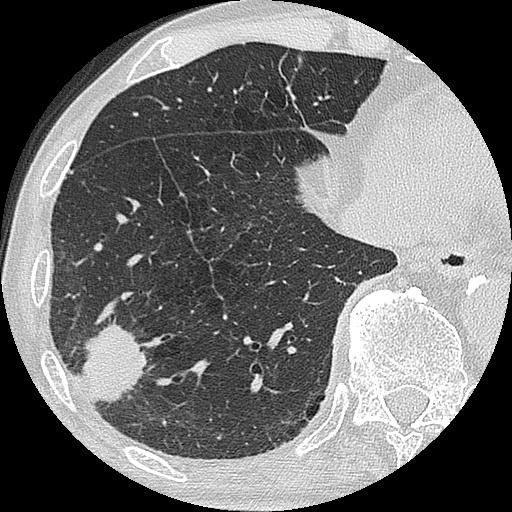Playlist
Show Playlist
Hide Playlist
Hypercoagulability as a Paraneoplastic Syndrome
-
Slides CP Paraneoplastic Syndromes.pdf
-
Reference List Pathology.pdf
-
Download Lecture Overview
00:01
Next up, hypercoagulability.
00:05
So this is basically an increased
risk of thrombosis because we have
activated one aspect of Virchow's triad.
00:13
We have made the host hypercoagulable, and
there are a variety of ways that we can do this,
but when it happens, you may get deep venous
thrombosis, then with pulmonary embolization,
or you can get nonbacterial thrombotic
endocarditis, the formation of thrombi on valves
that can then embolize and
cause injury someplace else.
00:40
So there's an increased risk of both of those
in the setting of a hypercoagulable state
driven by malignancy.
00:47
The mechanisms include the tumor,
causing extrinsic vascular compression,
and/or even invasion into a vessel.
00:55
And when that occurs, you're more prone
to forming a thrombus in that location.
01:01
Tumors and endothelial cells that are driven by
tumors through the vascular endothelial growth factor,
basic fibroblasts derived growth factor
etc, will produce more tissue factor.
01:15
Remember, tissue factor is going to be an important
component of the extrinsic coagulation cascade.
01:22
Because of the factors being made, and the
inflammation that results from malignancy,
you will see increased platelet activation and
there will be increased levels of platelets
because we will increase thrombopoietin
synthesis within the liver.
01:40
The tumor has on its surface a variety of
molecules, of which phosphatidyl serine,
one of the phospholipid components
of the membrane will be expressed
at higher levels in tumors and in tumor vasculature.
01:54
And that will support the activation
of the coagulation cascade,
as we've talked about in previous talks.
02:03
Again, the inflammation, that same
inflammation such as Interleukin-6
that's driving the production in the liver of hepcidin,
it's also driving in the liver the production of
coagulation factors VIII,
fibrinogen and von Willebrand factor
and so that's going to increase
the coagulability of blood.
02:23
And finally, because the tumor and tumor
vasculature expressing higher levels
of plasminogen activator inhibitor, we will
see a tendency to a more prothrombotic state.
02:36
So the endogenous fibrinolysis that
normally occurs will be inhibited by that
plasminogen activator inhibitor-1 expression.
02:44
So there are a lot of different ways to
that we're getting hypercoagulability.
02:47
How does this play out?
So I mentioned nonbacterial thrombotic endocarditis.
02:52
What you're seeing on the left
hand side is a mitral valve
and there's a big goober
otherwise known as a thrombus.
03:00
Nonbacterial endocarditis
thrombus on the surface of that.
03:05
This actually happens because we are
hypercoagulable,and if you think about it,
the normal valve leaflets are clapping up
against each other 60, 70, 80 times a minute.
03:17
And so normal valves are expressing or being
exposed to two of Virchow's triad all the time.
03:25
One is the trauma of the valve
leaflets closing against each other,
and the second is the relative areas of stasis.
03:31
Each time a valve closes,
there's a little area of stasis.
03:35
Now if we superimpose on top of
that, a hypercoagulable state,
we form this thrombus on the surface of the valve.
03:43
There is no infection in here.
03:45
In fact, the term non-bacterial thrombotic endocarditis
is bad because there's no inflammation either,
but we're stuck with that.
03:54
It's also called marantic endocarditis.
03:58
Either term is referring to these vegetations
that are on the lines of closure of the valve
and they are not causing any destruction,
but they're not firmly attached.
04:11
And as the valves clap open and
close 60, 70, 80 times a minute,
pieces of this vegetation can
flip off and go systemically,
so can cause embolic disease on the left
side of the body of the systemic vasculature.
04:28
What's been shown on the right
hand side is just this vegetation,
and it's a blend, platelets, fibrin and red cell
vegetation with lines of Zhan that you can see there
and it's just kind of lightly
stuck on the surface of the valve.
04:44
So that's one of the complications
of a hypercoagulable state.
04:47
Here's another major consequence
of a hypercoagulable state.
04:53
The very left hand side panel
is showing a deep leg vein
so this would probably be the
femoral vein in this patient
who has now completely thrombosed that.
05:05
If that thrombus in the deep leg vein embolizes,
breaks free and goes up towards the heart,
the next capillary bed, the next
vascular bed it's going to impact on
is going to be in the lungs.
05:17
And what's shown in the middle panel
is a very significant saddle embolus
going into the right and
left main pulmonary arteries.
05:30
What's being shown on the right
hand side is just what that
deep venous thrombosis would
look like if we cut through it
and you can see that there are laminations
in it, so this is forming these lines of Zahn.
05:41
This is a patient who is hypercoagulable
because of all the things that we talked about,
and died as a result not per se
directly of the cancer
but of the paraneoplastic state
associated with the cancer.
About the Lecture
The lecture Hypercoagulability as a Paraneoplastic Syndrome by Richard Mitchell, MD, PhD is from the course Cancer Morbidity and Mortality.
Included Quiz Questions
Which inflammatory-mediated molecules cause hypercoagulability in patients with cancer?
- Factor VIII and fibrinogen
- Hepcidin and fibrinogen
- Ceruloplasmin and hepcidin
- CRP and ferritin
- Transferrin and haptoglobin
Which statement is correct relative to cancer and hypercoagulability?
- Extrinsic vascular compression by a tumor increases the risk of thrombosis.
- Decreased tissue factor production by tumor and endothelial cells.
- Decreased platelet activation and accumulation
- Decreased expression of phosphatidylserine by tumor cells
- Elevated levels of protein C and S in serum
Customer reviews
5,0 of 5 stars
| 5 Stars |
|
5 |
| 4 Stars |
|
0 |
| 3 Stars |
|
0 |
| 2 Stars |
|
0 |
| 1 Star |
|
0 |




